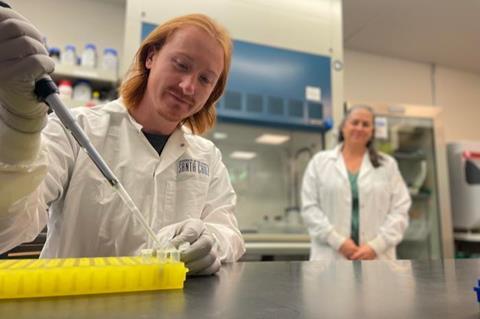Human astroviruses are a leading viral cause of the stomach bug—think vomiting, diarrhea, and fever. It often impacts young children and older adults, leading to vicious cycles of sickness and malnutrition, particularly for those in low and middle income countries. It’s very commonly found in wastewater studies, meaning it’s frequently circulating in communities. As of now, there are no vaccines for this virus.

New research from the lab of Rebecca DuBois, a professor of biomolecular engineering at the University of California, Santa Cruz, reveals the strategy that the human astrovirus uses to enter the body. A study detailing these results was published in the journal Nature Communications.
READ MORE: Wastewater could yield thousands of novel viruses, study reveals
“We uncovered a really important part of the virus lifecycle, and now we know exactly where on the virus this important interaction with the human receptor occurs,” DuBois said. “Now we can develop vaccines that will target it and block that interaction—it really guides future vaccine development.”
The team’s discovery also illuminates the possibility of repurposing existing, FDA-approved treatments to target astrovirus. DuBois and her team will continue to pursue both vaccines and treatments for astrovirus, with the support of around $416,000 via a new R21 award from National Institutes of Health.
Assessing astrovirus
The DuBois lab at the Baskin School of Engineering studies the molecular structure of viruses—mostly those that primarily affect children—to understand how they enter human cells and reveal new targets for vaccines and treatments.
Within the last two years, scientists discovered that astrovirus enters the body by binding to a protein in human cells called the neonatal Fc receptor. This receptor plays a key role in supplying antibodies to babies via breastmilk, and continues to support overall health later in life by moving antibodies and other proteins through the bloodstream.
However, it’s not enough to know what the virus binds to—it’s crucial to discover exactly how the binding works to allow the virus to enter the body. DuBois’ lab sought to understand how the virus engages this receptor at the molecular level.
Host machinery
“Viruses have to use host machinery to replicate, and the very first step is that the virus has to enter our cells,” said Adam Lentz, a Ph.D. student in DuBois’ lab who spearheaded this study. “That step of cell entry is where we’re really interested, and we want to fully understand how this happens—what proteins, what receptors, what other human factors it’s using to get inside. Ultimately, once we understand how it enters our cells, we can take the next step of figuring out how to stop it.”
To do so, the engineers created replicas of both the astrovirus and the receptor in the lab, mixing them together to observe exactly how and where the two bind. Using X-ray crystallography, a technique that reveals the structure of a protein at the atomic level, they discovered that the virus attaches to the same exact site on the receptor that antibodies do.
“The virus is hijacking the pathway that humans use for beneficial purposes to get inside the cell,” DuBois said. “I think that’s one of the most exciting findings—we discovered exactly how the virus is using this receptor to sneak into our cells.”
Antibody pathway
FDA-approved treatments already exist to target this antibody pathway for other disease contexts, such as for some types of auto-immunity. The research from the DuBois lab reveals a path to repurpose these treatments and test for their ability to protect against astrovirus disease —shortening the timeline for development of new therapies.
DuBois is particularly interested in developing vaccines for astrovirus, and the close study of astrovirus revealed that the pathogen frequently mutates near the location where it binds to the receptor. This means that the virus evolves often to evade the human immune system—much like influenza—and suggests that a multi-strain approach may be needed for an effective vaccine.
“If we can make a vaccine that is multivalent, we can protect against many strains of the virus,” DuBois said.







No comments yet